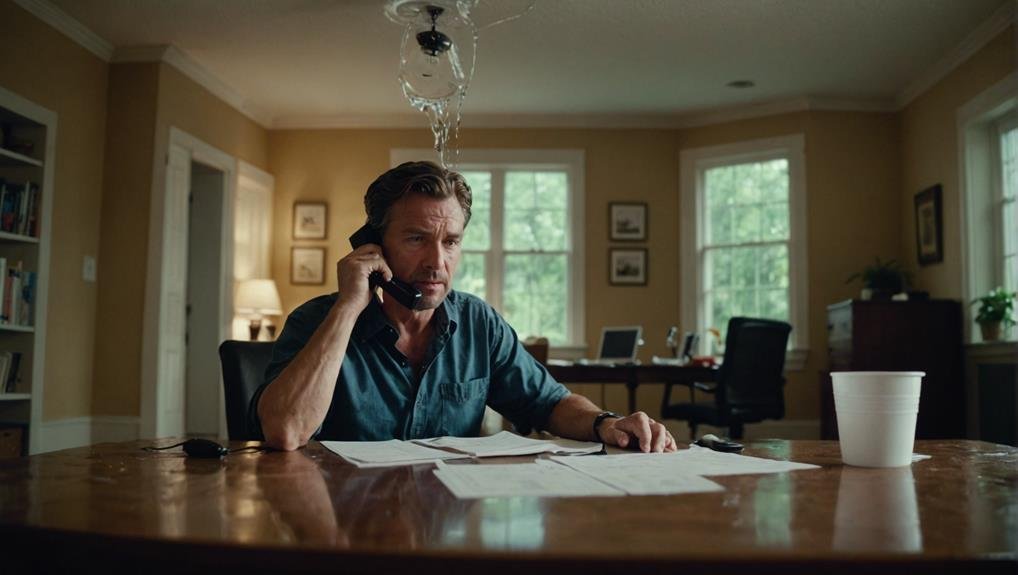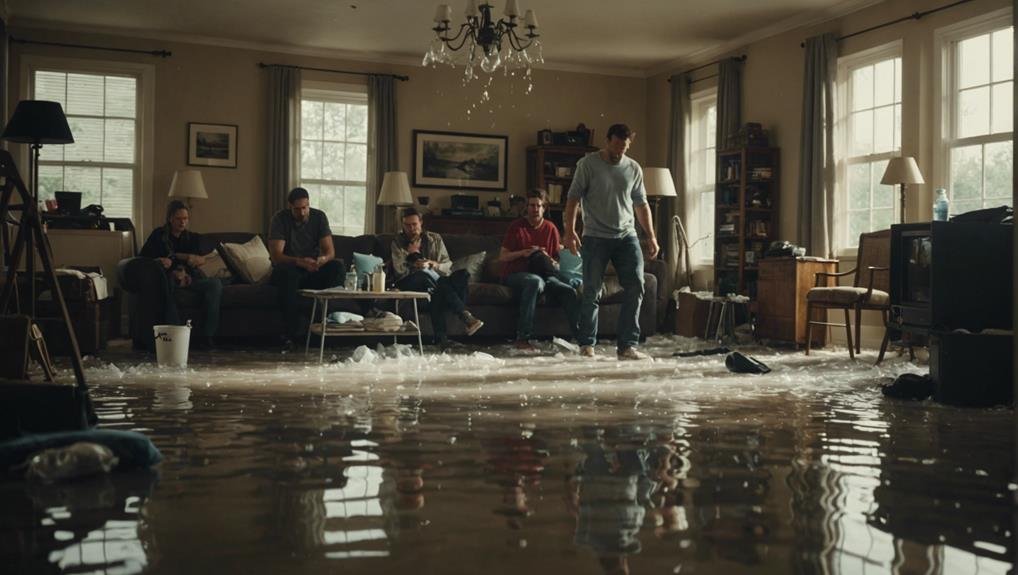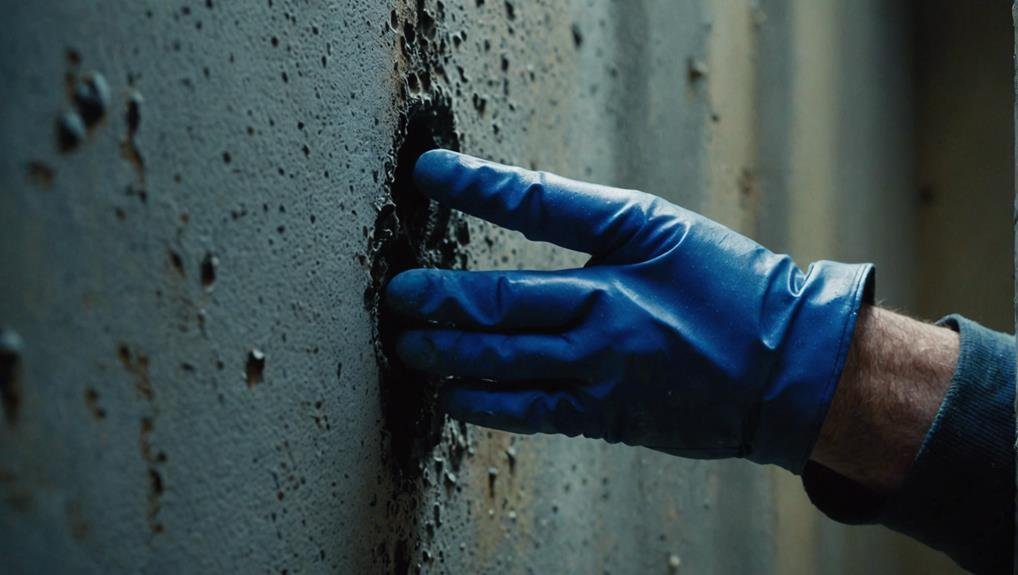When dealing with severe leaks, swift action is crucial. Begin by turning off the main water supply to halt the flow.
Take photos and videos to document the damage, then promptly contact your insurance provider to initiate the claims process.
Utilize towels, mops, or a wet/dry vacuum to remove excess water, ensuring proper disposal. Safeguard your belongings and furniture by relocating them from the affected area and covering them with plastic or tarps.
Keep the area well-ventilated to deter mold growth.
Following these initial steps, conduct a thorough inspection for mold and engage a professional plumber for repairs and more comprehensive solutions.
Turn Off Main Water Supply
When a severe leak happens, the first step is to locate and turn off the main water supply. This is crucial to prevent further damage by stopping the water flow and giving time to address the leak's source.
To find the main water valve, check near the water meter or where the main water line enters the building. Knowing this location beforehand is essential for quick action during emergencies. Once located, promptly turn off the valve to stop the water flow and protect the property from additional harm.
Document the Damage
Let's ensure we thoroughly document the damage to have all the necessary evidence for insurance claims and repairs. Start by taking clear photos or videos of the affected areas, showing the water damage extent, any valuables impacted, and visible structural damage. Check for mold growth or electrical hazards resulting from the leak.
Adding timestamps to our documentation is crucial. They help track the damage progression for insurance claims and repairs. By indicating when the damage happened and how it developed, we create a detailed timeline that aids in assessments.
Organize and store all documentation securely for easy access when filing insurance claims or hiring professionals for repairs. Proper documentation not only supports our claims but also helps accurately describe the damage to any professionals we engage with.
Contact Insurance Company

After documenting the damage, it's crucial to promptly reach out to our insurance company to kickstart the claims process. When dealing with a significant leak, this step is vital to ensure we receive the necessary assistance for repairs.
Providing detailed information about the leak to the insurance company is essential. This includes submitting any photos and videos we've taken to clearly show the extent of the damage.
When contacting the insurance company, it's important to follow any specific instructions they give for documenting and addressing the damage. They might have specific forms or procedures that need to be followed to ensure our claim is handled efficiently. Keeping accurate records of all communication with the insurance company will come in handy for future reference.
Once our claim is filed, we should be prepared for an adjuster assessment. An adjuster will visit our property to evaluate the damage firsthand and determine the coverage for repairs. This assessment is a crucial part of the claims process, so having everything well-documented and easily accessible will help make the experience smoother.
Remove Excess Water
When dealing with excess water, it's crucial to act swiftly to prevent further damage to your property.
The first step is to remove the water using towels, mops, or a wet/dry vacuum. These tools are effective for smaller amounts of water. For larger volumes, consider using a sump pump, which can efficiently eliminate standing water, especially in cases of significant water levels.
Proper disposal of the extracted water is essential to avoid property damage and environmental issues.
After removing the water, focus on thoroughly drying the affected areas to prevent mold growth and additional damage. Fans and dehumidifiers are helpful in speeding up the drying process by reducing moisture levels quickly and efficiently.
Protect Valuables and Furniture

Protecting valuables and furniture during a severe leak is crucial to minimize damage. Start by moving furniture away from the leaking area to prevent water damage. Cover items with tarps or plastic to shield them from getting wet.
Place buckets or containers under the leak to catch dripping water and prevent it from spreading. Remove rugs and carpets to avoid mold growth, which can be harmful.
Additionally, store valuable items in a dry, safe location until the leak is fixed to ensure they remain undamaged. Taking these immediate steps can save you from headaches and expenses in the future.
Act promptly to safeguard your possessions from the destructive effects of water damage.
Ventilate the Area
After securing our belongings and furniture, it's crucial to ventilate the area to reduce humidity and prevent mold growth. Opening windows and using fans helps circulate fresh air, lowering humidity levels to prevent further water damage and mold growth.
Proper ventilation not only aids in drying out excess moisture but also eliminates musty odors linked to water damage. With a steady flow of air, the drying process speeds up, restoring a healthy indoor environment faster.
For effective ventilation, position fans to promote cross-ventilation. Place one fan near an open window to push out humid air and another inside to pull in fresh air. Dehumidifiers can also help lower humidity levels, discouraging mold growth.
Maintaining good ventilation post-water leak ensures efficient drying and reduces the risk of long-term damage. By following these steps, we can create a healthier and safer living space.
Inspect for Mold

After a leak, it's crucial to promptly check for mold to prevent health issues and property damage. Mold can start growing within 24-48 hours, so quick action is key. Begin by inspecting hidden areas like behind walls, under carpets, and in ceiling spaces. These spots are often overlooked but can harbor mold, leading to allergies, respiratory problems, and skin irritations.
To ensure thorough inspection, consider mold testing and air quality assessments. These tests can reveal the extent of mold growth, guiding the necessary steps for effective remediation. If mold is detected, professional mold remediation may be necessary. Experts can safely remove mold and implement measures to prevent its recurrence, safeguarding both health and the structure of the property.
Here's a breakdown of key areas to inspect and why:
- Behind Walls: Mold can grow unseen here; consider opening walls to check for mold.
- Under Carpets: Moisture can trap mold beneath carpets; lift them to inspect underneath.
- Ceiling Cavities: Leaks from above can lead to mold growth; investigate cavities thoroughly to assess mold presence.
Call a Professional Plumber
When faced with significant leaks, it's crucial to contact a professional plumber promptly to prevent further damage. These leaks can escalate rapidly, leading to extensive water damage and potential structural issues if not addressed promptly. By reaching out to a professional plumber, you can rest assured that an expert will identify the source of the leak and efficiently repair it.
Professional plumbers possess the skills to pinpoint the exact location of the leak, even when it's hidden or in a challenging spot to access. They come equipped with the necessary tools and equipment to handle severe leaks effectively, preventing additional harm to our homes and avoiding expensive repairs in the future.
Choosing a licensed plumber guarantees that the repair is completed correctly and adheres to industry standards. Licensed plumbers undergo training to tackle complex plumbing issues, giving us peace of mind that the problem is resolved. Moreover, their work typically comes with a guarantee, ensuring that they'll return to address any recurring issues.
Conclusion
We've outlined the crucial steps for dealing with severe leaks. Firstly, immediately shut off the main water supply and document the extent of the damage.
Contact your insurance company and start removing any excess water. It's essential to safeguard valuable items and furniture, ensure proper ventilation, and inspect for any signs of mold growth.
Lastly, don't hesitate to call a professional plumber to address the issue promptly. Taking these actions swiftly will help resolve the problem efficiently and prevent any further damage from occurring.
By following these clear and concise steps, you can effectively manage this crisis.

